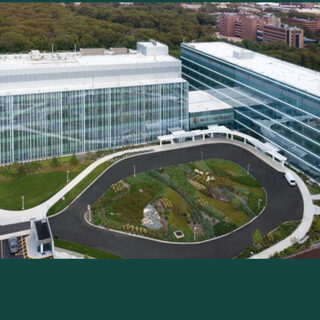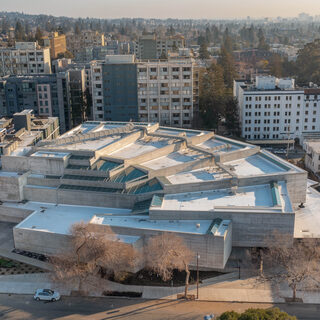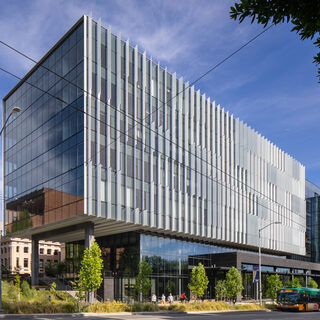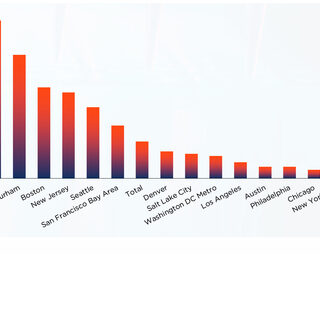Tradeline's industry reports are a must-read resource for those involved in facilities planning and management. Reports include management case studies, current and in-depth project profiles, and editorials on the latest facilities management issues.
Latest Reports
Stony Brook University’s New Ultra-Low-Temp Walk-in Freezer Farm
Stony Brook University’s Renaissance School of Medicine in Stony Brook, N.Y., has increased its capacity for ultra-low-temperature freezer storage, a need that became critical nationwide in early 2021 when the Pfizer COVID-19 vaccine required that level of storage, limiting which hospitals and pharmacies could offer it. Stony Brook’s new 560,000-sf Medical and Research Translation facility contains a low-temp walk-in (LTW) Freezer Farm suite with eight minus-80-degree-Celsius permanent storage chambers and a minus-20-degree-Celsius storage corridor with a combined capacity of over 1.8 million samples. This is the equivalent storage of 80 traditional point-of-use (POU) stand-alone freezer units.
Bakar BioEnginuity Hub Raises the Bar for Urban Adaptive Reuse Projects
The Bakar BioEnginuity Hub (BBH), a newly opened life science incubator in Woo Hon Fai Hall on the University of California Berkeley campus, sets a new standard for adaptive reuse of historically significant buildings. Originally completed in 1970, the 94,000-sf cast-in-place concrete building was designed by famed San Francisco architect Mario Ciampi as the home of the Berkeley Art Museum and the Pacific Film Archive. Considered an iconic example of mid-century brutalist architecture, the building was found to have significant seismic vulnerabilities after a campus-wide assessment was conducted in 1997. Despite installing temporary reinforcement bracing that improved the building’s seismic rating from “very poor” to “poor,” the museum ultimately moved to a new location in 2014, leaving the massive complex vacant until a decision was made in 2018 to transform it into a life science research incubator that also preserved the building’s historic legacy. While the bold adaptive reuse goal was laudable and widely supported, the architectural engineering and mechanical challenges of retrofitting the historic building to support the needs of a modern flexible life sciences lab were unprecedented.
Northwestern University Lab Building Exemplifies Next-Gen Workplace for Biomedical Research
Build the first 14 floors now, then add a 16-story tower a decade or so into the future. That was Northwestern University’s unconventional approach to the construction of the Louis A. Simpson and Kimberly K. Querrey Biomedical Research Center on the Chicago campus of its Feinberg School of Medicine. It wasn’t the only out-of-the-box decision that enabled the university to move forward with its vision of creating a 1.2 million-sf, next-generation research hub about 10 miles south of its main campus in Evanston. Similarly inventive is the ownership arrangement of the first half, which became the largest academic biomedical research building in the U.S. when it opened in 2019. One of the medical school’s three major hospital affiliates, Ann and Robert H. Lurie Children’s Hospital of Chicago, owns four of the nine lab floors (amounting to roughly 160,000 sf) and has easements to four-ninths of all the common space in the 625,000-sf structure.
Hans Rosling Center for Population Health
The Hans Rosling Center for Population Health at the University of Washington (UW) is designed to realize the vision of the university’s Population Health Initiative, a 25-year mission to address the most persistent and emerging global challenges affecting human health, environmental resilience, and social and economic equity. The nine-story Center provides space for collaborative group work, active learning, offices, and training for the UW Department of Global Health, the Institute for Health Metrics & Evaluation (IHME), the UW School of Public Health, and the offices of the Population Health Initiative. The project was made possible by a $210 million gift from The Bill & Melinda Gates Foundation and $15 million in earmarked funding from Washington State.
Life Sciences on the Rise
The global life sciences industry has been on the rise, growing more rapidly than ever over the past decade—well before the pandemic struck. In fact, its trajectory only accelerated throughout 2020 and into early 2021—with demand for its products surging and access to capital continuing to greatly expand in both periods. A record $70 billion of private and public capital (mostly venture capital and initial public offerings) poured into life sciences-related companies in North America in 2020, a 93 percent increase from the previous record of $36 billion received in 2018. And if investment continues at the pace we’ve seen in the first quarter of 2021 (already totaling $32.9 billion), we could see somewhere in the area of $90 billion raised this year alone. With COVID-19 challenging the sector last year like never before, the industry has clearly proven itself, sparking a light that illuminated a better way to work, collaborate, and innovate toward the hope of a vaccinated future. The speed at which COVID-19 vaccines have been developed and rolled out is a huge achievement for the pharmaceutical and biotechnology industries and is also a testament to the power of global collaboration. Now that we know what’s achievable in a relatively short amount of time, many will ponder what’s next for the life sciences industry. What else is it capable of doing? With the recent success of the COVID-19 mRNA vaccine technology, many researchers are increasingly seeing expanded possibilities in the technology to fight against infectious diseases, cancer, and more. This acceleration of the life sciences industry comes at a critical time, demonstrating the sector’s value and agility when the stakes have been so high.





